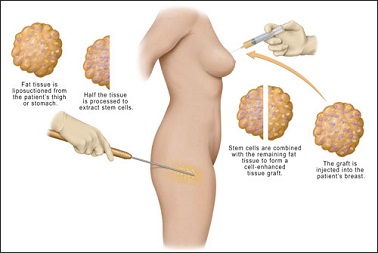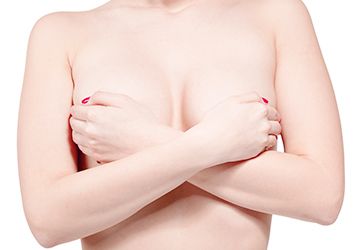
If you are looking for an effective way to enhance your breasts, you may be at a crossroads deciding which procedure is best for you. The two most popular options for women to improve their chest areas are breast implants or fat transfer.
Fat Transfer
Fat transfer is the harvesting of excess fat from an area of the body through liposuction and the re-injection of this processed fat to the breasts for additional volume and better shape. It gained popularity in the 1980s, primarily treating areas such as the breasts, buttocks, cheeks, and lips.
Interested in Fat Transfer Breast Augmentation?

MBAS doctors perform fat transfer breast augmentation to Ohio patients who have enough excess fat to be harvested. The procedure is best for patients who want to enhance their breasts but does not want to use implants.
Fat transfer can address uneven breasts and post-lumpectomy distortion and patients who are after modest results (about half a cup size bigger).
Advantages of Fat Transfer
The most significant advantage of fat transfer over breast augmentation is that it uses a patient’s tissues, so the breasts look and feel as natural as possible.
Here are the other advantages of the procedure:
- This technique offers patients little to no scarring since there is no introduction of foreign material.
- The procedure has a shorter recovery time.
- Breast and nipple sensation remains intact, and patients get to enjoy a slimmer and shapelier donor site.
Often, fat can be donated from the flanks (‘love handles’) and inner thighs. We know what you are thinking…. Family members can’t donate fat!
Disadvantages of Fat Transfer
While fat transfer comes with plenty of benefits, it also has its share of disadvantages:
- Its reliability is not as accurate as breast implants. Some fat may not survive the procedure and can disappear through being reabsorbed by the body.
- Fat transfer is also criticized for its temporary effect. Injected fat may be absorbed by the body over time, decreasing the resulting breast size.
- Fat transfer risk is calcification (or the death of fat cells), which may form cysts if they are large enough and hinder mammograms’ clarity.
- Fat transfer is also less reliable in patients that have undergone prior radiation treatment, whether after mastectomy or breast conservation treatment (lumpectomy + radiation treatment).
Watch: Fat Transfer Breast Augmentation After En Bloc Capsulectomy by Dr. Ergun Kocak
Breast Implants
Using breast implants is a highly reliable way for women to enhance their breast size and volume dramatically. It is the most commonly performed plastic surgery procedure, with over 200,000 performed every year. According to the FDA, patients should be at least 22 years of age before using silicone or gummy bear implants, while saline implants require patients to be at least 18 years old.
The best candidates for breast implants are those who have small breasts wanting bigger ones. Sagging or deflated breasts after pregnancy or extreme weight loss are best resolved by this procedure.
In the appropriate setting, implants may also be an option for breast cancer patients who desire reconstruction after a unilateral or bilateral mastectomy.
Advantages of Breast Implants
One of the significant benefits of breast implants is that it has been backed up by decades’ worth of research by medical and surgical experts, reinforcing their use’s safety. This is well-supported by the FDA’s approval of both saline and silicone implants.
Another benefit of implants over fat transfers is the longevity of the results lasting from 10 to 15 years under normal circumstances. Unlike fat transfer, breast implants produce immediate and apparent outcomes.
Disadvantages of Breast Implants
The downside of breast implants is they need to be replaced eventually, especially if they become deflated or ruptured. As quoted by the device manufacturers, the risk of implant rupture is approximately 1% per year. If the implant were to rupture, it would generally be removed and replaced. In other words, the longer a patient has an implant, the greater the likelihood that it would need replacement.
A commonly held misconception is that implants need to be removed every ten years. This is not true, and if the implant is intact and the patient has no issues with the implant, there is no need for surgery at the ten-year mark.
Here the other disadvantages of this technique:
- Another area of concern with implants is the formation of capsular contracture. Capsular contracture is due to hard scar formation around the implant.
- Finally, the type of incision used to insert implants may also affect sensation in the breast and nipple area.
Do You Feel Uneasy w/ Your Implants?

This may be due to capsular contracture. MBAS doctors offer Breast Implant Removal, an option for patients who want to remove their breast implants due to capsular contracture complications.
Fat Transfer or Breast Implants?
With the pros and cons mentioned above, it is safe to conclude that one procedure is not better than the other. It is only a matter of aligning your desired outcomes and the best way to achieve them.
Ultimately, if you want a small additional volume to your breasts, fat transfer may be the more practical option for you. If you want to increase your breast size by one or more cups, breast implants may suit you better. Consulting your surgeon and being realistic about your goals can help you arrive at a sound decision before embarking on the journey towards a more positive body image.
At Midwest Breast & Aesthetic Surgery, we prefer the natural way to breast enhancement. We believe that it is also safer than using implants — as implants possess a higher risk of autoimmune diseases.

One thought on “Breast Enhancement Options: Fat Transfer vs. Breast Implants”
well this looks amazing, and great instructions.